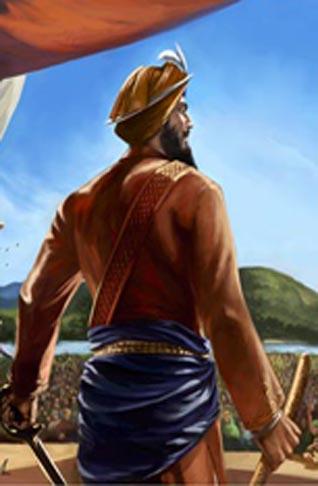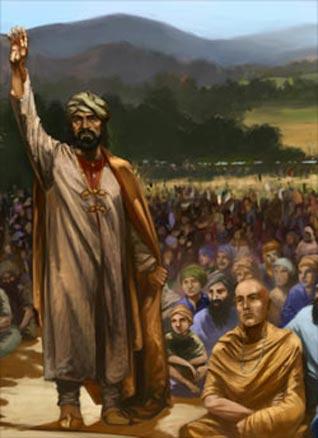
All images - details from the painting, "Vaisakhi" by Canadian artist Kanwar Singh (ArtofPunjab.com).

Talking Stick
What Is A Head Worth?
Ardaas, Part Five
The Talking Stick Colloquium # 37, Nov 22 - 28
Convenor: RAVINDER SINGH TANEJA
THE DIALOGUE - So Far
The Punj Pyarey, Chaar Sahibzaadey, Chaali Muktey model and reflect our collective aspirations: to be inner centered (Naam Juppna), working for the larger well being (Vund Chhakhna, Degh Chalaana, Tegh Vahni) with a spirit of charity, social concern
and forgiveness.
THIS WEEK
This week we move on to the remaining portion of the passage we touched on last week.
THE MESSAGE
This passage is believed to have been added to the ardaas in the latter part of the eighteenth century. It is a gory recitation and commemoration of Sikh martyrs who made the ultimate sacrifice of dying for Dharam - "dharam hayt sees dittay."
'Dharam' is a term with a long lineage and many shades of meaning. For our purposes, dharam is to be viewed as the moral imperative, the notion that one chooses righteous action to uphold the Truth, even at the cost of one's life.
The line, 'dharam hayt sees dittay," is perhaps the most significant in this passage.
It connects to a subsequent line, "sikhi kesaan suaasaan naal nibaahi" and it is to this connection that I would like to turn our attention this week.
The various modes of torture - the cutting of a limb at every joint; the scalping of heads; the wheel of death and being sawed alive - that were used by the tyrants to kill Sikhs are rooted in specific events in history.
The first, "bundh bundh kataa-ey," refers to Bhai Mani Singh, a close associate of Guru Gobind Singh (although his family connections can be traced back to the Sixth
Guru). As custodian of the Darbar Sahib at Amritsar, he was executed by the
Mughal authorities on trumped up charges.
"Khopriaa-a(n) luhaaiaa-a(n)" or being scalped alive notes the story of Bhai Taru Singh who gave up his life rather than be coerced into Islam. Traditional accounts describe how the twenty five year old was reciting the Japji as he was being tortured and killed.
The story of the father and son, Bhai Shahbeg Singh and Bhai Shahbaj Singh is the point of remembrance for "Charkhiaa-a(n) attay charhey."
"Aaray-aa(n) naal chiraa-ay gae," is a reference to the martyrdom of Bhai Mati Das and Bhai Sati Das, who were sawed alive in Guru Tegh Bahadar's presence, in an attempt to get the latter to waiver from his resolve.
The reference to gurdwaras points to milestones in recent Sikh history: Guru ka Bagh, Jaito and Nankana Sahib.
The list of martyrs in the Sikh ardaas is clearly meant to keep us linked to our past, lest we forget. But more importantly, it is also meant to remind us that to stand on principle and lead a life of integrity is an ideal that should guide the course of our
lives even today.
LET'S PONDER TOGETHER
I chose the English title of his piece from an essay titled, "What is a Head Worth?" by Dr. I.J. Singh. It is an inspirational piece of writing and one that raises questions that are very pertinent to this discussion. I could not possibly pose the questions better, so I choose to quote from that essay:
Now three hundred years after Guru Gobind Singh, is there anyone asking for a head?
When a business associate suggests that a little greasing of the palm could smooth the way for your project or when a prospective employer hints that a job or a promotion could be yours if you appear without your Sikh uniform, why should you resist? If the road you take is less than straight and narrow, why does it matter? If social life could be easier without the long hair or the Sikh uniform, why not take the easy road? Why look to the road less traveled? Haven't times changed?
Guru Gobind Singh is not asking for heads now, or is he?
[Please click here to read the complete article.]
To give one's head has a meaning beyond physical death. It also suggests dying to one's ego and being re-born in the Spirit. In practical terms, this means adopting the ethical and moral framework of Gurmat as we go about our daily lives.
- How consciously are we engaged in a "dharam yudh", the daily battle of the mind?- How do we deal with temptations that assail us from all sides?
Is dying for dharma the same as dying for one's beliefs? Socrates is said to have claimed that he would rather die for his beliefs than live someone else's. Bertrand Russell, on the other hand, said he would never die for his beliefs because he could
be wrong.
November 22, 2010
Conversation about this article
1: Mohan Singh (Toronto, Ontario, Canada.), November 22, 2010, 10:32 AM.
Allah Yaar Khan loved Guru Gobind Singh and with love wrote so much about Guru Sahib that Muslims became very jealous, called him a kafir (unbeliever) and did not allow him to enter a mosque for 30 years. When he had become an old man, a Qazi went to his house and said to him, "Jogia, come with me and ask for forgiveness. You have grown old and should die as a true Muslim." Allah Yaar Khan replied: "I have done nothing wrong. What I wrote about Guru Sahib is the truth and I will not go back." Hearing this, the Qazi became angry, and said, "Then you want to die as a kafir?" Yaar Khan replied: "I am a kafir from Mohammad but not for Guru Gobind Singh Ji. I see Guru Sahib sitting in bahisht (heaven) with open arms and waiting for me. I want His love and want to die as His servant." The Qazi left and Allah Yaar Khan died remembering Guru Sahib in his every breath.
2: I.J. Singh (New York, U.S.A.), November 24, 2010, 4:33 PM.
Ravinder, thank you very much for posting a note from my old essay. I can't resist the temptation of adding a little from its concluding lines. "Yes, 300 years have passed. Guru Gobind Singh no longer appears in person at the job interview, flashing a naked sword and asking for your head. Mysterious are the ways of the Guru ... The flashing sword is replaced by the prospect of social isolation, economic disaster or harassment at the job or in the neighborhood. The instrument ... is the affable man or woman behind the desk asking all these awkward questions. The intent of the questions is the same; only the form is different. Many will slip away just as they did 300 years ago. Many more will look away just as they did then. The question is: How are you going to answer the call?"
3: Ravinder Singh Taneja (Westerville, Ohio, U.S.A.), November 25, 2010, 11:10 AM.
Thank you, Dr I.J. Singh ji for reiterating the question I was trying to pose: how, indeed, are we going to answer the call - or, to put it another way, what do our choices and life-style tell us about how we are answering the call? The passage from the ardaas is more than a remembrance; it is a reminder for us to live principled lives.
4: Nirmal Singh Nilvi (Texas, U.S.A.), November 28, 2010, 1:31 PM.
We are expected to opine on two battles. Our personal struggles in daily life where the issue of "answer the call to offer your head" rarely comes up any more in the Sikh realm. Sikhs appear to be fighting this battle well and succeeding. We are likely to do even better with time. However, in the Sikh religious realm, the issue becomes complex with no simple answers but I am willing to share my views in a limited way. I sincerely believe that there will no shortage of 'heads' offered for the sacrifice, provided we can find someone with half the attributes demonstrated by Guru Gobind Singh. I will not be surprised to see more shirking minds among those who pretend to be his true followers. This opinion is based on a careful evaluation of 500 hundred years history. Guriu Gobind Singh asked us to follow Guru Granth as our Guru. We are still struggling to understand it and use it mostly to seek bounties. He asked us to manage Sikh affairs through the "Punj Pyare" concept; we use them in a few processions and celebrations, etc. That's it. The central question derived from Dr. I.J. Singh's write up is a good one. He writes well with a rare ability to cover the issues and inspire the reader with his style. In the year 2010, we know the make up of Sikhs in the diaspora is different and growing wider. While I have no personal issue with the question raised, 'What is a head worth?" the answer may not be in the hands raised, because the article may not resonate equally well among all Sikhs in the diaspora. We need them all because they are the true back-bone of Sikhi. We need to rise above our personal preferences and learn to nurture and bring together our differences under one umbrella of the Guru Granth. Only then can we fairly raise inspiring questions like "How are you going to answer the call?" The number of hands raised may surprise us all.


